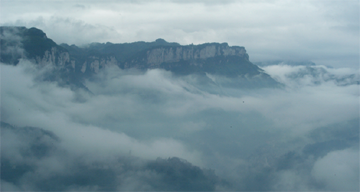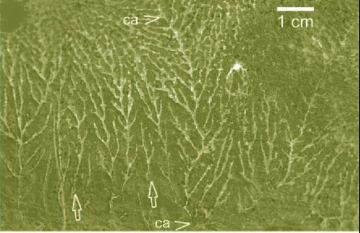Geotimes

Untitled Document

Web Extra
Monday, July 25, 2005
Rare
3-D fossil preservation
Ediacara organisms are among the oldest known life forms, having
lived more than 540 million years ago. But until now, scientific knowledge about
the creatures has come from fossils in the form of molds and casts with only
their external features preserved. A new fossil locality in southern China,
however, is giving paleontologists a more detailed look at the early body plans
of these strange creatures.
Ediacara fossils — representing
small, soft-bodied creatures without mineralized skeletons — are usually
captured in sandstones. Most Ediacara organisms are thought to have disappeared
altogether during the beginning of the Cambrian Explosion, 544 million years
ago, when a whole host of new life forms began to emerge with hard, mineralized
skeletons, such as trilobites and mollusks. Because the Ediacara fossils are
usually molds and casts, it is difficult to describe them, interpret their lifestyles
or put them in an evolutionary context.
 In
the 1980s, Yale University paleontologist Adolf Seilacher proposed that some
Ediacaran organisms shared a particular body plan and grouped them together,
calling them vendobionts. No one knows exactly what these creatures are, but
the new fossils found in the Dengying Formation of southern China by a team
of scientists from Virginia Tech and the Nanjing Institute of Geology and Paleontology
in China reveal some new details of the curious branching structures.
In
the 1980s, Yale University paleontologist Adolf Seilacher proposed that some
Ediacaran organisms shared a particular body plan and grouped them together,
calling them vendobionts. No one knows exactly what these creatures are, but
the new fossils found in the Dengying Formation of southern China by a team
of scientists from Virginia Tech and the Nanjing Institute of Geology and Paleontology
in China reveal some new details of the curious branching structures.
A
team of paleontologists recently discovered well-preserved Ediacara fossils
in limestone in the Precambrian Dengying Formation, located atop of this mountain
in southern China. Below the Dengying, obscured by the clouds in the photograph,
lies the older Doushantuo Formation, dated between 635 and 551 million years
old. Images courtesy of Bing Shen.
Radiometrically dated between 551 and 538 million years old,
the newly discovered vendobionts, preserved in a limestone matrix, have internal
structures replaced by calcite spars, says Bing Shen, a graduate student at
Virginia Tech and co-author of the paper, published in the July 11 Online Early
Edition of the Proceedings of the National Academy of Sciences. The creatures
have a unique body plan never before seen in living or extinct creatures, Shen
says.
Previously, Seilacher, who first described the organisms in detail from molds
and casts, hypothesized that vendobionts were made up of enclosed tube-like
structures, connected together and filled with cytoplasm, much like an air mattress
meant for the swimming pool, says David Bottjer, a paleoecologist at the University
of Southern California at Santa Cruz, who was not involved with the research.
Analyzing thin-sections of the fossils, Shen and the team verified that the
organisms did have a tube-like structure internally, but each tube was not enclosed.
Rather, one end was open to the environment, which means "they could not
be filled with cytoplasm, as predicted by Seilacher," Shen says.
 The
fossil find is "verification that there are biota that may not exist any
more," Bottjer says, and it tells us that before the Cambrian Explosion,
"there were a lot of strange things out there." No definitive evidence
points to whether these strange creatures are plant or animal. "We don't
know," he says, "but maybe it's not related to anything." To
learn more, "we need to go out and look for other places" where these
types of carbonate formations may hold 3-D specimens of other early organisms,
Bottjer says.
The
fossil find is "verification that there are biota that may not exist any
more," Bottjer says, and it tells us that before the Cambrian Explosion,
"there were a lot of strange things out there." No definitive evidence
points to whether these strange creatures are plant or animal. "We don't
know," he says, "but maybe it's not related to anything." To
learn more, "we need to go out and look for other places" where these
types of carbonate formations may hold 3-D specimens of other early organisms,
Bottjer says.
These
branching structures are fossil "vendobionts," some of the oldest organisms
found on Earth. The exceptional 3-D preservation of their soft bodies may shed
light on early life.
Shen and his colleagues plan to perform other analyses of the specimens, including
some geochemical work. They will also return to the field in search of more
Ediacara fossils in the previously overlooked carbonate rocks. "It is important
to search more limestone for different fossil anatomies [and] ecologies,"
Shen says. What exactly the vendobionts were and how they lived is still a point
of speculation.
Indeed, the team has several ideas about why the organisms went extinct during
the Cambrian, including a change in the environment. Another possibility, they
say, is that because the vendobionts were sedentary creatures — lying about
on the seafloor — organisms that could burrow into and crawl across the
ocean bottom may have disrupted the lifestyle of the vendobionts.
Laura Stafford
Back to top
Untitled Document

 In
the 1980s, Yale University paleontologist Adolf Seilacher proposed that some
Ediacaran organisms shared a particular body plan and grouped them together,
calling them vendobionts. No one knows exactly what these creatures are, but
the new fossils found in the Dengying Formation of southern China by a team
of scientists from Virginia Tech and the Nanjing Institute of Geology and Paleontology
in China reveal some new details of the curious branching structures.
In
the 1980s, Yale University paleontologist Adolf Seilacher proposed that some
Ediacaran organisms shared a particular body plan and grouped them together,
calling them vendobionts. No one knows exactly what these creatures are, but
the new fossils found in the Dengying Formation of southern China by a team
of scientists from Virginia Tech and the Nanjing Institute of Geology and Paleontology
in China reveal some new details of the curious branching structures.
 The
fossil find is "verification that there are biota that may not exist any
more," Bottjer says, and it tells us that before the Cambrian Explosion,
"there were a lot of strange things out there." No definitive evidence
points to whether these strange creatures are plant or animal. "We don't
know," he says, "but maybe it's not related to anything." To
learn more, "we need to go out and look for other places" where these
types of carbonate formations may hold 3-D specimens of other early organisms,
Bottjer says.
The
fossil find is "verification that there are biota that may not exist any
more," Bottjer says, and it tells us that before the Cambrian Explosion,
"there were a lot of strange things out there." No definitive evidence
points to whether these strange creatures are plant or animal. "We don't
know," he says, "but maybe it's not related to anything." To
learn more, "we need to go out and look for other places" where these
types of carbonate formations may hold 3-D specimens of other early organisms,
Bottjer says.